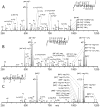The effect of fixed charge modifications on electron capture dissociation
- PMID: 18657441
- PMCID: PMC3116146
- DOI: 10.1016/j.jasms.2008.06.014
The effect of fixed charge modifications on electron capture dissociation
Abstract
Electron capture dissociation (ECD) studies of two modified amyloid beta peptides (20-29 and 25-35) were performed to investigate the role of H* radicals in the ECD of peptide ions and the free-radical cascade (FRC) mechanism. 2,4,6-Trimethylpyridinium (TMP) was used as the fixed charge tag, which is postulated to both trap the originally formed radical upon electron capture and inhibit the H* generation. It was found that both the number and locations of the fixed charge groups influenced the backbone and side-chain cleavages of these peptides in ECD. In general, the frequency and extent of backbone cleavages decreased and those of side-chain cleavages increased with the addition of fixed charge tags. A singly labeled peptide with the tag group farther away from the protonated site experienced a smaller abundance decrease in backbone cleavage fragments than the one with the tag group closer to the protonated site. Despite the nonprotonated nature of all charge carriers in doubly labeled peptide ions, several c and z* ions were still observed in their ECD spectra. Thus, although H* transfer may be important for the NC(alpha) bond cleavage, there also exist other pathways, which would require a radical migration via H* abstraction through space or via an amide superbase mechanism. Finally, internal fragment ions were observed in the ECD of these linear peptides, indicating that the important role of the FRC in backbone cleavages is not limited to the ECD of cyclic peptides.
Figures











Similar articles
-
Electron capture dissociation of hydrogen-deficient peptide radical cations.J Am Soc Mass Spectrom. 2012 Oct;23(10):1729-40. doi: 10.1007/s13361-012-0433-8. Epub 2012 Aug 2. J Am Soc Mass Spectrom. 2012. PMID: 22855421
-
Electron capture in charge-tagged peptides. Evidence for the role of excited electronic states.J Am Soc Mass Spectrom. 2007 Dec;18(12):2146-61. doi: 10.1016/j.jasms.2007.09.009. Epub 2007 Sep 18. J Am Soc Mass Spectrom. 2007. PMID: 17951069
-
Toward a general mechanism of electron capture dissociation.J Am Soc Mass Spectrom. 2005 Feb;16(2):208-24. doi: 10.1016/j.jasms.2004.11.001. J Am Soc Mass Spectrom. 2005. PMID: 15694771
-
Radical-driven peptide backbone dissociation tandem mass spectrometry.Mass Spectrom Rev. 2015 Mar-Apr;34(2):116-32. doi: 10.1002/mas.21426. Epub 2014 May 26. Mass Spectrom Rev. 2015. PMID: 24863492 Review.
-
Reactions of polypeptide ions with electrons in the gas phase.Mass Spectrom Rev. 2003 Jan-Feb;22(1):57-77. doi: 10.1002/mas.10042. Mass Spectrom Rev. 2003. PMID: 12768604 Review.
Cited by
-
Effects of peptide backbone amide-to-ester bond substitution on the cleavage frequency in electron capture dissociation and collision-activated dissociation.J Am Soc Mass Spectrom. 2011 Aug;22(8):1441-52. doi: 10.1007/s13361-011-0151-7. Epub 2011 May 5. J Am Soc Mass Spectrom. 2011. PMID: 21953199
-
Probing the mechanisms of electron capture dissociation mass spectrometry with nitrated peptides.Phys Chem Chem Phys. 2010 Nov 7;12(41):13394-9. doi: 10.1039/c0cp00623h. Epub 2010 Sep 8. Phys Chem Chem Phys. 2010. PMID: 20830387 Free PMC article.
-
Formation of peptide radical cations (m+·) in electron capture dissociation of peptides adducted with group IIB metal ions.J Am Soc Mass Spectrom. 2011 Feb;22(2):233-44. doi: 10.1007/s13361-010-0035-2. Epub 2011 Feb 1. J Am Soc Mass Spectrom. 2011. PMID: 21472583
-
Does Electron Capture Dissociation Cleave Protein Disulfide Bonds?ChemistryOpen. 2012 Dec;1(6):260-8. doi: 10.1002/open.201200038. ChemistryOpen. 2012. PMID: 24363980 Free PMC article.
-
Chemical derivatization of peptide carboxyl groups for highly efficient electron transfer dissociation.J Am Soc Mass Spectrom. 2013 Nov;24(11):1710-21. doi: 10.1007/s13361-013-0701-2. Epub 2013 Aug 6. J Am Soc Mass Spectrom. 2013. PMID: 23918461 Free PMC article.
References
-
- Little DP, Speir JP, Senko MW, Oconnor PB, McLafferty FW. Infrared Multiphoton Dissociation of Large Multiply-Charged Ions for Biomolecule Sequencing. Anal Chem. 1994;66:2809–2815. - PubMed
-
- Gauthier JW, Trautman TR, Jacobson DB. Sustained Off-Resonance Irradiation for Collision-Activated Dissociation Involving Fourier-Transform Mass-Spectrometry - Collision-Activated Dissociation Technique That Emulates Infrared Multiphoton Dissociation. Anal Chim Acta. 1991;246:211–225.
-
- Zubarev RA, Kelleher NL, McLafferty FW. Electron capture dissociation of multiply charged protein cations. A nonergodic process. J Am Chem Soc. 1998;120:3265–3266.
-
- Kelleher RL, Zubarev RA, Bush K, Furie B, Furie BC, McLafferty FW, Walsh CT. Localization of labile posttranslational modifications by electron capture dissociation: The case of gamma-carboxyglutamic acid. Anal Chem. 1999;71:4250–4253. - PubMed
-
- Stensballe A, Jensen ON, Olsen JV, Haselmann KF, Zubarev RA. Electron capture dissociation of singly and multiply phosphorylated peptides. Rapid Commun Mass Spectrom. 2000;14:1793–1800. - PubMed
Publication types
MeSH terms
Substances
Grants and funding
LinkOut - more resources
Full Text Sources

